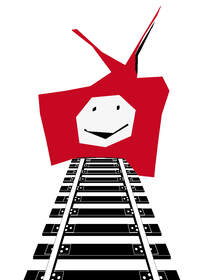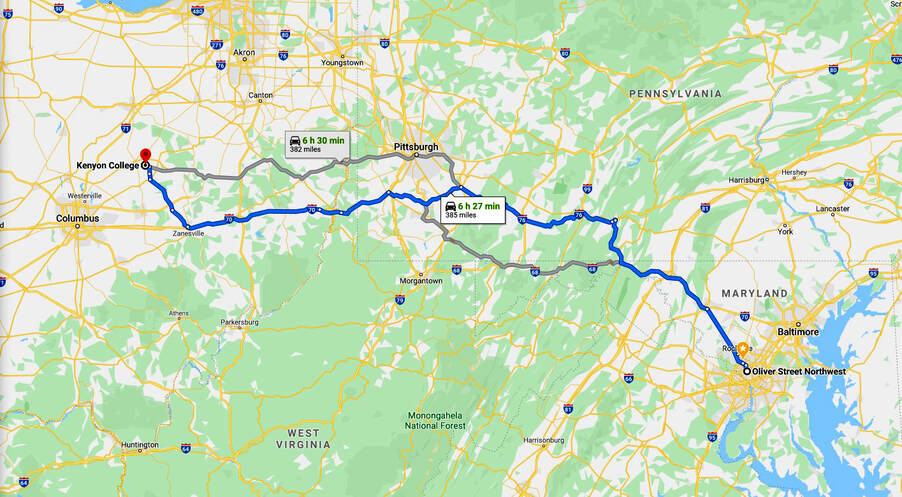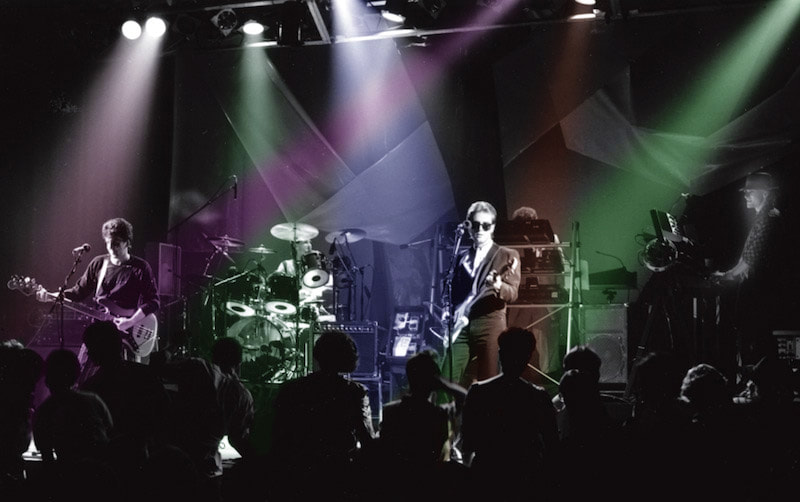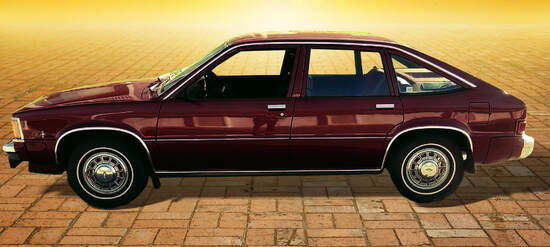 A man needs a motor…
A man needs a motor…
In the spring of ’83 I was midway through my second semester of graduate school in Film & Video at The American University. I had a documentary script to write, a photo essay to mount, a paper to research for my Television Programming class, and a short film with “anomaly” as the theme to shoot and edit by the end of the month which was already half over. So what was I doing? Gassing up my trusty Chevy Citation and heading to Kenyon College for the weekend to visit the love of my life. In the backseat was a duffle bag with some clothes, a Bolex camera, a rickety wooden tripod, two 50ft spools of Kodak Tri-X black and white 16mm film, and a sheaf of Xeroxed blank storyboard pages in desperate need of stick figured inspiration. Seated next to me was a mixed bag of emotions vociferously debating all the way across Pennsylvania whether this was a wise “road trip of the heart” to be making right now.
The time and distance between Washington, DC and Gambier, Ohio—along with action-packed graduate and undergraduate school schedules—made for a challenging, but not impossible, long-distance relationship. It was "distance learning" before there was such a thing. Although the obstacles—more speed bumps than full-fledged road blocks—could be subdued with clichéd, character-building encouragement like: "Distance makes the heart grow fonder," we relied more on stacks of handwritten letters and cards, and the occasional luxury of a long distance phone call that neither one of us could really afford financially or emotionally. We also both did our best to finagle a weekend away in DC or Ohio at least every other month. For Lori it usually meant snagging a ride from someone who was coming east or convincing a mutual friend that 14 hours in a car sounded like a fun way to spend the weekend. (Even back then Lori's powers of persuasion were formidable!) For me it usually meant bookending a brief weekend together with a somewhat brutal six or seven hour solo drive. Looking back, those road trips were tedious, but they definitely contributed to the magic of our romance. Despite all the time-consuming turnpike travel we both managed to get all our work done, and stay madly in love.
My trip to Kenyon in April was a little more fraught with anxiety. I really had a shit-ton of work to do and not much time to do it. I was notoriously reliable under pressure with a deadline, but my nagging traveling companion of mixed emotions cast doubt on my decision all the way to the Ohio border. So I left him at rest stop just outside of Zanesville and continued driving… and thinking about anomalies. By the time I left the highway and entered Knox County, I had a rough idea for a film that I suppose, by today’s standards, might be potentially offensive and politically incorrect. Inside my head hurtling through the moonlit Ohio countryside, the idea seemed innocently wacky and passably avant-garde. I had a campus location in mind: The Bexley Art Gallery. I had ready-made props courtesy of the Senior class art exhibit. I had a willing cast eager to do anything in front of the camera for the right amount of beer and pizza. And most importantly, I had the perfect song for the soundtrack.
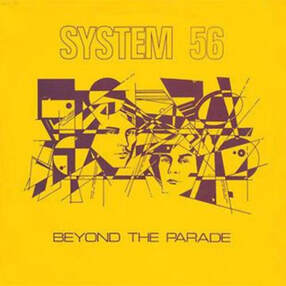
In the early 80s synth-pop was all the rage and I was a big fan of Depeche Mode, A Flock of Seagulls, Ultravox, The Human League, and Gary Numan. Clearly, so were Steve Simenic and Vince Scafiti, the dynamic duo behind Cleveland’s mesmerizing System 56. I had already worn out the grooves on their brilliant debut single by the time their six-song EP hit the local record stores. Beyond the Parade continued to promote the promise of their inevitable stardom with a half-dozen guitar/synth pop gems. The band garnered critical acclaim, as well as both college and commercial support, on local Cleveland airwaves. However, as the group had recently been reduced to just Scafiti and Simenic, live performances were put on hold while the two continued to recruit replacement members, and moved forward with additional studio sessions. Eventually, synthesist Paul Teagle and bass player Tom Lash joined the band, and two more singles were released while the band continued to hone its cool, snappy, synth-based sound to easily rival the likes of the bands that had inspired and influenced them.
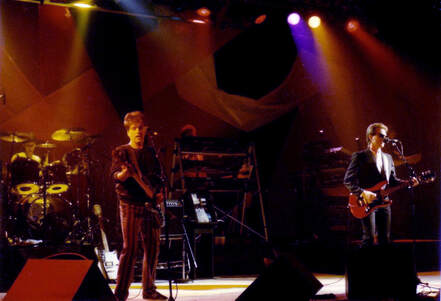
On September 28, 1984 System 56 made their live Cleveland debut performing to an enthusiastic sold-out audience of 1000 at the Phantasy Theatre in Lakewood. A second synth player, Dennis Richie, was added to the lineup for two more successful shows at the Phantasy later that year and then, just as it seemed like all the stars were finally aligned, and the band had indeed achieved life on a cool curve, Steve Simenic recounts: “as 1985 rolled around, the forces holding the band together were being exceeded by the forces pulling it apart, and not long afterwards, we quietly disbanded, for a variety of reasons. Life's other priorities have a curious way of nibbling away at a band's foundation, and we were no exception. Looking back, it was an eventful 3-year ride, and a memorable one, but ultimately a limited one.” And just like that, one of Cleveland's most talented and promising bands was gone.
But I’m getting ahead of my story with the band’s history. When I rolled into Gambier on that Friday night in April, I owned everything System 56 had released, and it was a song from Beyond the Parade that I had decided to base my film on. Poor Lori was looking forward to a weekend visit and a reprieve from her busy senior-year schedule, but instead she got a preview of me in full-on production mode. Over late night beers and pizza at the Pirates Cove I hatched my plan on sauce-stained storyboards. Lori showed no signs of disappointment, and jumped right into the pre-production brainstorming fray; recruiting friends to be in the film and chasing down props. I don’t know if we ever actually got permission to film in Bexley the following night—all I remember is someone, probably Ed, meeting us outside the building with a ring of keys and the gallery was ours for the rest of the night. Thanks to my storyboards and a frugal, 2:1 shooting ratio with 100ft of film, we were in and out of the gallery before you could say “Hello Security? I’d like to report a disturbance.” The following day we shot an exterior scene that was needed, and then I hopped in the car and headed back to DC. During most of the drive I listened repeatedly to a cassette of Beyond the Parade, and mentally edited footage from the weekend’s filming with the song "Through Other Eyes" until I pulled up in front of the house I lived in on Oliver Street.
The finished project met with positive reviews from professors and peers alike, and the visual of a blind man in an art gallery viewing an exhibit “through other eyes,” satisfied the criteria of the assignment without offending anyone — especially once I justified the concept with some creative writing about beauty being in both the eye, and the mind’s eye, of the beholder. Many years later with graduate school behind me, System 56 released a compilation of all their music entitled Retrospective: 1982-1984. That online discovery and unexpected digital upgrade to some well-worn vinyl prompted me to revisit my 16mm film school project, make some digital enhancements and embellishments, and sync the film with the new, crackle-free version of the song. Throwing all caution to the wind, I tracked down the band's founder, Steve Simenic, who had relocated to California, and sent him a copy of the revitalized 27-year old student film. Steve was thrilled when the “unexpected artifact suddenly re-contextualized out of the decaying echoes of the past to manifest in a new form,” and allowed me to officially post it on YouTube with the band's blessing. Over the past ten years it has accumulated 3800 views and, according to Steve, introduced many new fans to the band’s music. Looking back, like most things I’ve done, the film for “Through Other Eyes” could have been so much better. If I knew then what I know now…even the 17-year old "enhancements and embellishments" look their age now, and the poor film-to-tape transfer overlays everything with a quirky strobing effect that was never intentional. Technical shortcomings aside, I think posterity will be grateful for this memorable moment from Cleveland's rock n' roll history. I really think it’s the collaborative spirit of the endeavor that pulls it through; the same collaborative spirit that prevails to this day whenever Lori and I hatch a plan together.
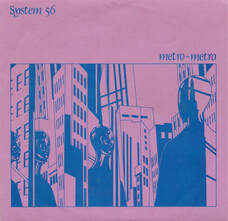
In 1982 it seemed like System 56 burst onto the Cleveland music scene with perfect timing. Hometown support was generous, and the band rewarded its fans with an album's worth of songs that easily rivaled the likes of similar groups receiving wider acclaim. But like so many things in life, reality has a nasty habit of barging in to rewrite the script and direct the scene from a different perspective. I don’t know how talented artists like Steve Simenic and his bandmates from System 56 move on when the greatness that should have been, falls prey to the indifferent forces of reality, but they do. I suppose that’s why I feel a constant compulsion to keep readjusting the spotlight on musical history and direct it towards bands like System 56 whose music deserves a much bigger audience and greater appreciation. With that illuminating thought in mind, the Happy Medium Song of the Day is the very first song I heard by System 56, the A-side of their debut single, “Metro Metro.” Little did I know when I first heard it's insanely catchy chorus, that a few years later I'd be humming it everyday on my way downtown to work on the DC Metro. (Please use the comments box below to share your thoughts.)
